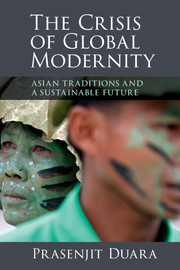Book contents
- Frontmatter
- Epigraph
- Contents
- List of figures and maps
- Preface and Acknowledgements
- Introduction
- 1 Sustainability and the crisis of transcendence
- 2 Circulatory and competitive histories
- 3 The historical logics of global modernity
- 4 Dialogical and radical transcendence
- 5 Dialogical transcendence and secular nationalism in the Sinosphere
- 6 The traffic between secularism and transcendence
- 7 Regions of circulation and networks of sustainability in Asia
- Reprise and Epilogue: of reason and hope
- Bibliography
- Index
- References
7 - Regions of circulation and networks of sustainability in Asia
Published online by Cambridge University Press: 05 January 2015
- Frontmatter
- Epigraph
- Contents
- List of figures and maps
- Preface and Acknowledgements
- Introduction
- 1 Sustainability and the crisis of transcendence
- 2 Circulatory and competitive histories
- 3 The historical logics of global modernity
- 4 Dialogical and radical transcendence
- 5 Dialogical transcendence and secular nationalism in the Sinosphere
- 6 The traffic between secularism and transcendence
- 7 Regions of circulation and networks of sustainability in Asia
- Reprise and Epilogue: of reason and hope
- Bibliography
- Index
- References
Summary
The globalization of the last few decades has brought forth some unexpected developments that in turn have recast our perspectives on modern history. Regions such as the European Union, Mercosur, NAFTA and ASEAN have emerged as intermediate zones between the deterritorializing impulses of capitalism and the territorial limits of nationalism. The search for markets and resources drives corporations. Not-for-profit organizations are also seeking out and creating new transnational spheres of activity, and their numbers have expanded dramatically over the last twenty years. At the same time, still other considerations tend to limit the transnational drive to more geographically and historically familiar regions.
Let us recall that the cartographic representation of Asia does not represent any natural or cultural unity. Indeed, Asia was merely the name of the area east of the Greek ecumene in ancient times. But that does not mean that there were no empires and networks of activity spanning and linking different parts of the region. Today, Asia, centered on ASEAN, is one of the more important – though by no means the only – core areas around which Asian societies and nations are coalescing. These coalescing networks evoke historical patterns of circulation whose salience evaporated or was marginalized by the centrality of national histories during much of the twentieth century.
- Type
- Chapter
- Information
- The Crisis of Global ModernityAsian Traditions and a Sustainable Future, pp. 239 - 278Publisher: Cambridge University PressPrint publication year: 2014

